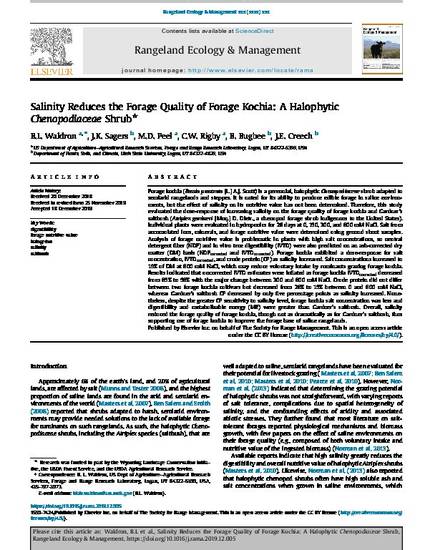
Forage kochia (Bassia prostrata [L.] A.J. Scott) is a perennial, halophytic Chenopodiaceae shrub adapted to semiarid rangelands and steppes. It is noted for its ability to produce edible forage in saline environments, but the effect of salinity on its nutritive value has not been determined. Therefore, this study evaluated the dose-response of increasing salinity on the forage quality of forage kochia and Gardner’s saltbush (Atriplex gardneri [Moq.] D. Dietr., a chenopod forage shrub indigenous to the United States). Individual plants were evaluated in hydroponics for 28 days at 0, 150, 300, and 600 mM NaCl. Salt from accumulated ions, minerals, and forage nutritive value were determined using ground shoot samples. Analysis of forage nutritive value is problematic in plants with high salt concentrations, so neutral detergent fiber (NDF) and in vitro true digestibility (IVTD) were also predicted on an ash-corrected dry matter (DM) basis (NDFcorrected and IVTDcorrected). Forage kochia exhibited a dose-response for salt concentration, IVTDcorrected, and crude protein (CP) as salinity increased. Salt concentrations increased to 19% of DM at 600 mM NaCl, which may reduce voluntary intake by ruminants grazing forage kochia. Results indicated that uncorrected IVTD estimates were inflated as forage kochia IVTDcorrected decreased from 65% to 56% with the major change between 300 and 600 mM NaCl. Crude protein did not differ between two forage kochia cultivars but decreased from 26% to 15% between 0 and 600 mM NaCl, whereas Gardner’s saltbush CP decreased by only five percentage points as salinity increased. Nonetheless, despite the greater CP sensitivity to salinity level, forage kochia salt concentration was less and digestibility and metabolizable energy (ME) were greater than Gardner’s saltbush. Overall, salinity reduced the forage quality of forage kochia, though not as dramatically as for Gardner’s saltbush, thus supporting use of forage kochia to improve the forage base of saline rangelands.
